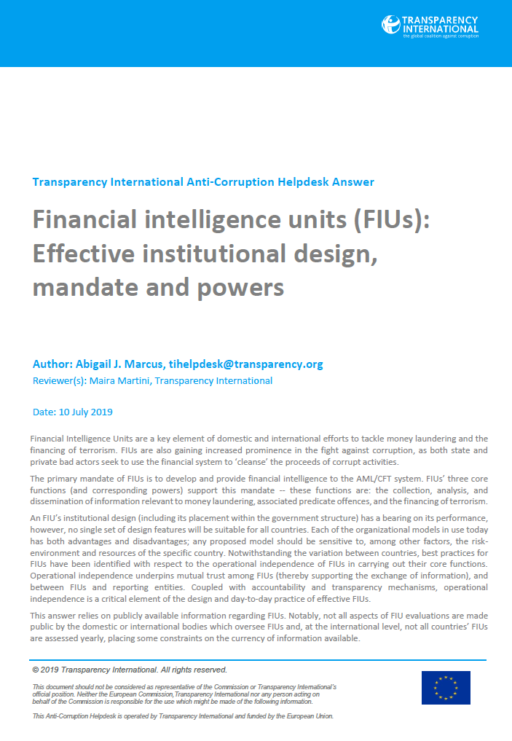- Home
- Anti-Corruption Helpdesk
- Financial intelligence units (FIUs): Effective institutional design, mandate and powers
Financial intelligence units (FIUs): Effective institutional design, mandate and powers

This Anti-Corruption Helpdesk brief was produced in response to a query from one of Transparency International’s national chapters. The Anti-Corruption Helpdesk is operated by Transparency International and funded by the European Union.
Query
What is the best institutional setup for financial intelligence units within the government structure? Please provide examples of best practices from around the world.
Summary
Financial Intelligence Units are a key element of domestic and international efforts to tackle money laundering and the financing of terrorism. FIUs are also gaining increased prominence in the fight against corruption, as both state and private bad actors seek to use the financial system to ‘cleanse’ the proceeds of corrupt activities.
The primary mandate of FIUs is to develop and provide financial intelligence to the AML/CFT system. FIUs’ three core functions (and corresponding powers) support this mandate -- these functions are: the collection, analysis, and dissemination of information relevant to money laundering, associated predicate offences, and the financing of terrorism.
An FIU’s institutional design (including its placement within the government structure) has a bearing on its performance, however, no single set of design features will be suitable for all countries. Each of the organizational models in use today has both advantages and disadvantages; any proposed model should be sensitive to, among other factors, the risk- environment and resources of the specific country. Notwithstanding the variation between countries, best practices for FIUs have been identified with respect to the operational independence of FIUs in carrying out their core functions. Operational independence underpins mutual trust among FIUs (thereby supporting the exchange of information), and between FIUs and reporting entities. Coupled with accountability and transparency mechanisms, operational independence is a critical element of the design and day-to-day practice of effective FIUs.
This answer relies on publicly available information regarding FIUs. Notably, not all aspects of FIU evaluations are made public by the domestic or international bodies which oversee FIUs and, at the international level, not all countries’ FIUs are assessed yearly, placing some constraints on the currency of information available.
Content
- What are FIUs?
- Location of FIU within the government structure
- Focusing on operational independence: best practices
- Looking ahead: new and continuing challenges facing FIUs
- References and further reading
Main points
- National FIUs are an essential component of the international AML/CFT system, including tracing laundered proceeds of corruption.
- The model or form of an FIU should be sensitive and responsive to local conditions.
- Regardless of form, an FIU’s operational independence is critical to the FIU carrying out its core functions: collecting, analysing and disseminating relevant financial information.
- Trust and integrity underpin the cooperation between domestic and foreign FIUs, and supports private sector confidence in FIUs.
Authors
Abigail J. Marcus, [email protected]
Reviewer
Maira Martini, Transparency International
Date
15/07/2019
Tags
 Download PDF
Download PDF
